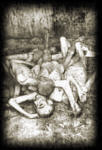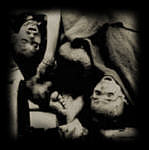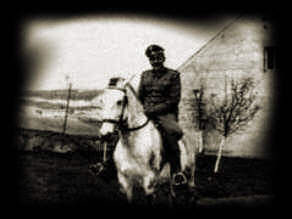






Born in Vienna Amon Goeth joined a Nazi youth group at seventeen, moved to a nationalist paramilitary group at nineteen, and, in 1930, when he was twenty-two, joined the then outlawed Austrian Nazi Party. He was designated No. 510,964, and in the same year he joined the S.S.
Amon Goeth fled to Germany when he was pursued by Austrian authorities for crimes involving explosives. His superior officers admired his devotion, gave him glowing personal evaluations and transferred him to the S.S. A son was born in 1939 and died of unexplained causes less than a year later. Amon Goeth was a model officer, and his reward was a posting, in August, 1942, with Aktion Reinhard, the S.S. operation to liquidate more than two million Polish Jews.
His posting as commandant at Plaszow was his career zenith ...



The conditions of life at Plaszow
were made dreadful by Amon Goeth. A prisoner in Plaszow was lucky if he survived
more than four weeks. Collective punishment became frequent, torture and
death were daily events. Groups passing one another on different work shifts
reported the daily number killed.
In 1943 on Yom Kippur, an important holiday of the Jewish year, Goeth and his SS-men took 50 Jews from the barracks and shot them. Often prisoners were publicly hung, with more than 15,000 inmates lined up on the ground. Moshe Beijski - a Schindler Jew who later became a High Court Judge in Israel - gave this testimony at the trial of the war criminal Adolf Eichmann:
"All those people stood on the ground, and the two persons were brought to the gallows: a lad of 15, Haubenstock, and the engineer Krautwirt, and an order was given to hang them. It was said in the camp that young Haubenstock had sung a Russian tune. The boy was hanged and something happened which occurs once in many thousands of cases - the rope broke. The boy stood there, he was again lifted on to a high chair which was placed under the rope, and he began to beg for mercy. An order was given to hang him a second time. And then he was raised a second time to the gallows, and hanged, and thereafter that same Amon Goeth, with his own hands, also fired a
shot.
The engineer Krautwirt, throughout that time, stood on the second chair, and here the perfidy went even further. SS men, with their guns, and machine guns, passed through the ranks, and gave orders to all those standing on the ground to watch. Engineer Krautwirt cut the veins of his hands with a razor blade, and in this condition went up to the gallows. And in this way he was hanged."
At the same trial Moshe Beijski told more about Amon Goeth and the other methods of punishment used by the Camp Commandant:
"The case of Olmer, whose daughter lives in Jerusalem, and I know her .. He was summoned by the Camp Commandant Amon Goeth. The Camp Commandant had two dogs, Ralf and Rolf, and he set the dogs on him. The dogs ate him up alive. Possibly a little breath still remained in him. He shot him and he was
killed ..
A
group that appeared with food in its possession .. a particular group of the
Abladekommando, a unit which was in charge of the offloading of goods from the
railway station - they found food in its possession. Then the camp commander,
Untersturmfuehrer Amon Goeth, came up and asked whose food it was. When no one
answered, he took a young man whose name was Nachmansohn .. and shot him. On the
same occasion he shot another man, Disler. And then someone had a brilliant idea
and said that they had brought the food .. Then everyone received one hundred
lashes.
One
of the men - named Mandel - remained lying there until the group was taken to
the parade ground, and there everyone received his deserts. He himself
had to count the blows, and if he made an error in the counting, he had to go
back to the beginning .. There was an instance with that group where one of the
older men was beaten and cried out a great deal, and after that had to go to
Goeth and to inform him that he had received his punishment, and he thanked him
for it. When he turned around, he shot him, and he, too, was killed."

The brother of Moshe Beijski, Dov Beijski, survived Plaszow, too. He later recalled:
"Early
in May 1944 we were all paraded and ordered to strip naked. All inmates were run
before him and he sent them right or left, to which side the old, weak and
defective or juvenile were sent. Two days later they were separated, placed on
good wagons and were joined by the 250 children in the camp. The outcry was
stifled by SS guns pointed at us all, and loudspeakers played lullabies. More
than 1200 adults and 250 children were taken to Auschwitz and the death chambers.
One boy of 12 or 13 named Jerzy Spiro managed to escape and hid all day in the
cesspit at the latrine, with only his head uncovered. I do not know whether he
survived the war .."
At Plaszow Amon Goeth passed his mornings by using his high-powered, scoped rifle to shoot at children playing in the camp. Rena Finder, one of Schindler's Jews then 14 years old, later remembered Goeth as " .... the most vicious and sadistic man ...". Another Schindler-Jew, Poldek Pfefferberg, recalled Goeth this way: "When you saw Goeth, you saw death."
A survivor, Arthur Kuhnreich, later told about Amon Goeth in his Holocaust Memories: "I saw Goeth set his dog on a Jewish prisoner. The dog tore the victim apart. When he did not move anymore, Goeth shot him."
The 20-year-old Schindler-worker Isak Pila had made the mistake of falling asleep under a table at the factory the same day that Amon Goeth came by for an inspection. When Goeth saw the sleeping boy, he told Oscar Schindler to kill him instantly. Schindler desperately tried to find a way out and hit the boy on one side of the face, then the other. Finally he said to Goeth, 'He's had enough. I need him ...' And Isak Pila survived the Holocaust.
Oscar Schindler somehow managed to outwit Goeth and the Nazis. When he requested that his Jews were moved into their own sub-camp near the plant 'to save time in getting to the job,' Goeth complied. From then on, Schindler found that he could have food and medicine smuggled into the barracks with less danger. The guards, of course, were bribed, and Goeth never was to discover it, though Oscar Schinder was arrested twice.

At the point when his ambitions have been
realized and he could walk away from the war a rich man while his Jews die in Auschwitz,
Oscar Schindler desperately spends every penny he has bribing and
paying off Amon Goeth and other Nazi officials in order to be
allowed to move 1,100 of them out of Poland to the relative
safety of a new factory in Czechoslovakia.
In a symbolic reversal of his earlier purpose in life, Schindler now spends all the money he made by exploiting the labour of Jews in buying the lives of Jews. Whatever is not spent in bribing Goeth and other Nazi officials is subsequently spent in feeding his Jews.
Amon Goeth was arrested in the autumn of 1944 in connection with an investigation of corruption and black market activities in the camps, the same investigation that brought about the execution of Karl Koch and Hermann Florstedt. Goeth was also suspected of embezzlement, but before he could be put on trial the war ended.

He was recuperating in an SS-sanitarium in Bad Tolz when he was arrested by Patton's troops in February 1945. The Americans turned him over to the Poles.
In his memoirs Death Dealer the SS Commandant at Auschwitz, Rudolph Hoess - history's greatest mass murderer - later recalled: 'During that time a crowd had gathered and angrily cursed at us. Major Goeth was recognized immediately. If the car had not arrived when it did, we would have been bombarded with stones ...'
At the trial at the Supreme National Tribunal of Poland, Cracow, 27th - 31st August and 2nd - 5th September, 1946, Goeth was found guilty and convicted of the murders of tens of thousands of people.
(1) Amon Goeth as commandant of the forced labour camp at Plaszow (Cracow) from 11th February, 1943, till 13th September, 1944, caused the death of about 8,000 inmates by ordering a large number of them to be exterminated.
(2) As a SS-Sturmführer Amon Goeth carried out the final closing down of the
Cracow ghetto. This liquidation action which began on 13th March, 1943, deprived
of freedom about 10,000 people who had been interned in the camp of Plaszow, and
caused the death of about 2,000.
(3) As a SS-Hauptsturmführer Amon Goeth carried out on 3rd September, 1943, the
closing down of the Tarnow ghetto. As a result of this action an unknown number
of people perished, having been killed on the spot in Tarnow. Others died
through asphyxiation during transport by rail or were exterminated in other
camps, in particular at Auschwitz.
(4) Between September, 1943, and 3rd February, 1944, Amon Goeth closed down the
forced labour camp at Szebnie near Jaslo by ordering the inmates to be murdered
on the spot or deported to other camps, thus causing the death of several
thousand persons.

Amon Goeth at the trial
During his trial Goeth displayed provocative indifference. He accepted responsibility for what happened at Plaszow. He had been given authority and permission to do everything he had done, he said, and was only carrying out orders and instructions received from his superiors. He also contended that the penalties he was inflicting upon the inmates including putting them to death, were within his disciplinary jurisdiction as commandant of the camp, and were in accordance with the German regulations in force.
Goeth appealed for mercy to the President of the State National Council. After the President had decided not to avail himself of his prerogative of pardon, the sentence was carried out.
Amon Goeth was
hanged for his crimes on September 13, 1946, not far from his camp. And even though he is being
hanged, Amon Goeth
still salutes his Fuhrer in one final act of
defiance ...
Steven Spielberg's famous film Schindler's
List focused attention on people like Oscar Schindler and his wife Emilie
Schindler, who - at great risk
to themselves and their families - helped Jews escape the Nazi genocide. In
those years, millions of Jews died in Nazi death camps like Auschwitz, but Oscar
Schindler's Jews miraculously survived. Schindler spent millions to protect and
save his Jews, everything he possessed. He died penniless.
But he earned the everlasting gratitude of his Jews.
sources:
The outstandfing Letter from Berlin by Gerald Posner, The New Yorker, March 14, 1995
Law-Reports of Trials of War Criminals, The United Nations War Crimes Commission
University
of the West of England
The Nizkor Project
Schindler's List Teaching Guide
USHMM
- Photo Archives
www.auschwitz.dk
www.oskarschindler.com
www.emilieschindler.com
www.shoah.dk
© 2014-2016 Louis
Bülow Privacy
All Rights Reserved.